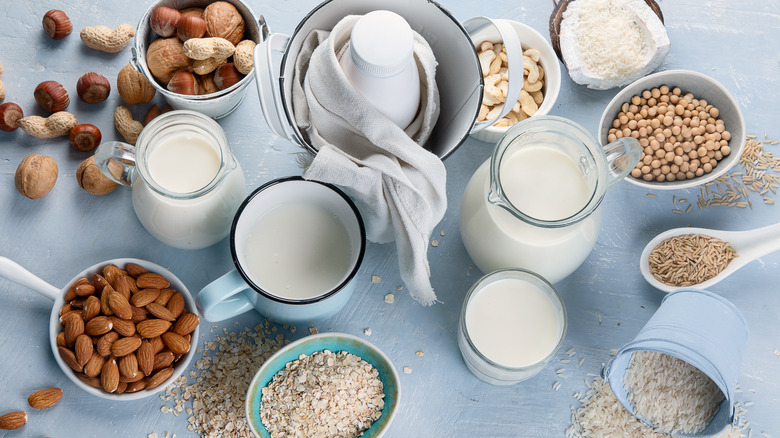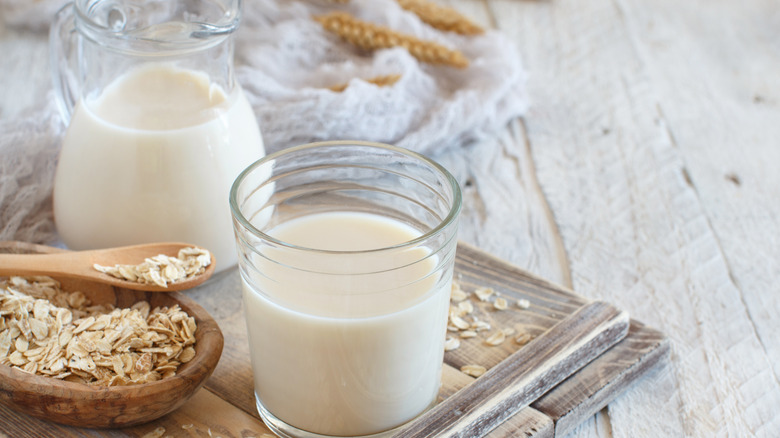Is Lactose-Free The Same As Dairy-Free?
In a world where everyone is increasingly careful of what they consume, avoiding confusion and having the right information is crucial. In fact, the increasing popularity of lactose-free products and an increased campaign for dairy-free foods have caused the average milk consumption in the U.S. to go down over a few decades, according to data from the U.S. Department of Agriculture. Two terms that are quite common on food labels that are often confused are "lactose-free" and "dairy-free." Understanding the difference between these two terms is particularly important, especially for anyone with an underlying allergic reaction to dairy products.
If you are an avid consumer of milk or any dairy products, you must have come across these two terms. While they are unified by milk, these two terms are more different than similar. To make it simple, the major difference between the two is that lactose-free products are made of dairy, while dairy-free means strictly no dairy products. With this information, you will be able to make informed decisions that also have an impact on the health of your family and yourself. Here is what you need to know about lactose-free and dairy-free products.
What does dairy-free actually mean?
Right from the jump, it is necessary to understand what the term dairy means before digging any deeper. Dairy essentially refers to milk, or any part of milk, not just from cows but from any mammal. Products with dairy-free labels do not contain casein and whey, which are the two main proteins contained in milk, according to a study published by Lipids in Health and Disease. It is important to also point out that lactose-free products don't necessarily mean that they are dairy-free.
The process of extracting these proteins does not remove the lactose, which is also an ingredient found in dairy products. However, dairy-free products do not have any milk components and are also considered lactose-free. Milk is high in protein; in fact, an 8-ounce glass of milk has around 8 grams of protein (via the University of Rochester Medical Center). Dairy-free products, on the other hand, often have less protein compared to their dairy counterparts.
What does lactose-free actually mean?
Lactose is the primary natural sugar found in milk and other dairy products. According to MedicineNet, this sugar can be further broken down into two main components: glucose and galactose. This is particularly necessary for the absorption of lactose into the body. Lactose-free products are designed specifically for individuals who are lactose intolerant. Remember: Lactose is only found in milk, so you need to be careful when purchasing any product made with milk, such as hot chocolate or even sour cream.
The good news is that most food products, including those made of dairy products, have labels indicating whether they are lactose-free or not. If you are lactose intolerant, you don't have to eliminate all dairy products from your diet. After all, dairy products come with a lot of health benefits. Harvard Health Publishing mentions that dairy products like milk have plenty of nutrients and fat that are essential in bone and cardiovascular health.
Lactose intolerance
As mentioned earlier, lactose is a sugar found in milk that is broken down into glucose and galactose to facilitate absorption into the body. Lactose intolerance occurs when the body fails to produce the enzyme lactase, which is supposed to break down lactose (via Cleveland Clinic). While lactose intolerance is a malfunction of the body, it is important to point out that it is not life-threatening and only manifests in the form of stomach upsets, nausea, and bloating, just to mention a few. The severity of these symptoms is different from one person to the next. While it might be mild for one person, the symptoms can also be debilitating for someone else.
There are several possible reasons for an inability to produce enough lactase enzyme. According to Mayo Clinic, lactose intolerance might occur as a normal process right after weaning an infant. The child's body is likely to start producing fewer enzymes and might get even worse as the years go by. Unfortunately, lactose intolerance is quite common in the U.S., affecting between 30 to 50 million people, according to the National Digestive Diseases Information Clearinghouse (via Cornell Chronicle).
Dairy Allergies
Milk allergies, better referred to as dairy allergies, are quite different from lactose intolerance. While lactose intolerance is about the deficiency of the enzyme lactase in the body, a dairy allergy is an immune response to the proteins found in milk. WebMD describes it as the immune system treating the whey and casein proteins in milk as harmful foreign bodies. The allergic reaction manifests in mild or severe symptoms, such as itching, swelling, trouble breathing, and wheezing, among many others.
While milk allergies are not quite as common in the adult population, it is quite prevalent among children. Unfortunately, lactose-free products are not safe for those with dairy allergies. This is because the immune system is fighting the proteins — not the sugar — found in milk. In this regard, if you have any form of dairy allergy, the best course of action is to stay away from dairy products and look for suitable alternatives, Mayo Clinic recommends.




